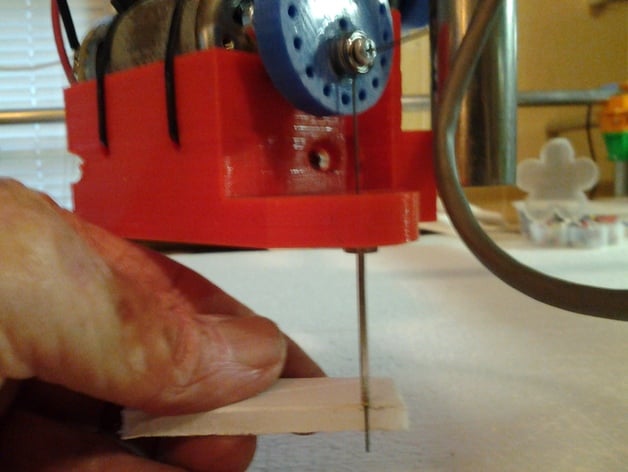
MPCNC foam-cutter attachment
thingiverse
Human: Easy-to-make foam cutter for Mostly Printed CNC (http://www.thingiverse.com/thing:724999) by Ryan "allted" Zellars'. Quickly cuts through $tree foamboard or 1/4" fanfold foam insulation board with precise control. Reuses a salvaged DC motor from an old inkjet printer or battery-powered drill, paired with a .025" music-wire needle, small ball-bearing with 3mm bore, and sports-ball inflation needle for smooth guidance. Adjusting the motor voltage ensures optimal performance - 10-15 strokes/perforations per mm yields precise cuts on paper and foam. Secure the needle loop tightly around the drill bit shank just under the bearing OD to create a stable connection. Use three 10mm screws to mount the bearing in an off-center hole, placing a small washer between the inner race and plastic wheel for smooth operation. Slightly groove the outer race with a Dremel and cutoff wheel to prevent wire needle loop movement. Dress the needle point using a fishhook sharpener to eliminate burrs and improve precision. For ideal performance, maintain needle exposure at 2-3 mm below the guide's end. This setup yields excellent results at a feedrate of 1000 mm/min and cutter speed of 10000 rpm (strokes/min). Originally inspired by "A Foam Cutting Machine" by Tom McGuire - http://makeict.org/wiki/Foam_Cutting_Machine To see it in action, visit https://www.youtube.com/watch?v=kRLBNsZTKgM. UPDATE: A revised version 2 of the foam cutter has been developed, utilizing a smaller, higher-rpm motor. This resulted in enhanced cutting performance, especially when using piano-wire needles (instead of Mig-wire). Version 3 boasts an even more powerful motor from an old discarded drill. Additionally, the motor holding fixture has been adjusted to simplify mounting. UPDATE 11/29: The latest model incorporates significant improvements with a stronger motor and better balancing system, including short screws placed around the periphery for precision balancing. UPDATE 12/03: A refined flywheel/eccentric design was introduced to replace previous components, allowing smoother operation up to nearly 10000 rpm in the shown configuration. Post-printing adjustments Troubleshooting vibration If your setup is plagued by excessive vibration, check if "shaft_eccentrics" are balanced with a RC prop balancer... or test by attaching loose wires and hardware to the bearing side. In my case, adding more weight through various adjustments and screws eliminated most vibrations, clearly legging 'Johnson' branding on the motor during operation. Improved needle performance Exchanging MIG-wire needles for piano- or music-wire ones improved overall speed and quality of cuts, thanks to reduced bending issues. Piano-wires proved particularly effective at providing smoother, straighter cuts than similar MIG-wires I'd initially used.
With this file you will be able to print MPCNC foam-cutter attachment with your 3D printer. Click on the button and save the file on your computer to work, edit or customize your design. You can also find more 3D designs for printers on MPCNC foam-cutter attachment.
